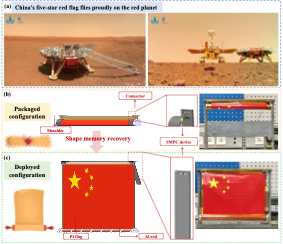Dou Zhang, Liwu Liu, Pengfei Xu, Yinzhong Zhao, Qifeng Li, Xin Lan, Fenghua Zhang, Linlin Wang, Xue Wan, Xin Zou, Chengjun Zeng, Xiaozhou Xin, Wenxu Dai, Ying Li, Yanchun He, Yanju Liu*, Jinsong Leng*
Smart Materials and Structures. 2022, 31:115008
DOI: 10.1088/1361-665X/ac93d1
The China National Space Administration released images on June 11, 2021, taken by the country's first Mars rover Zhurong. The success of the Tianwen-1 mission marked China's pride in becoming the second country after the United States to successfully landed on the red planet. The excitement generated by China’s five-star red flag flying proudly on the red planet was shared around the world. Just as eye-catching as images of the Martian surface itself was the Chinese national flag on the Zhurong rover's landing platform. After the historic landing on May 15, China's national flag was slowly unfurled from the glistening lander on the red planet.
An ancient papyrus scroll-inspired mechanism was designed to deploy the national flag. Compared with existing pasting or printing schemes which were used by NASA and in Chang’e Missions, it provided a dynamic deployment. Firstly, release devices made of shape memory polymer composites, as the key to switch folded and deployed configurations, were characterised by dynamic mechanical analysis static tensile tests, of which the results assisted the computational modal analysis. The first-order natural frequencies at 55 ℃ and 85 ℃ decrease by 4.94% and 9.93%, respectively, compared with those at 25 ℃. Simulation results at 25 ℃ were compared with vibration data to validate the feasibility of the finite element method and the effectiveness of results at high temperatures. Besides, the creep effect of this macromolecular polymer was also taken into consideration. The radii of curvature increased by 0.08 mm and 0.26 mm after creeping for 96 hours at 55 ℃ and 85 ℃, respectively, of which the mechanical performance was evaluated by vibration tests. Additionally, ground-based deployment was conducted at normal temperature and pressure, and in a vacuum chamber. The mechanism possessed excellent adaptability to the power supply and ambient temperature, with release time varying from 0.5 min at -70 ℃ and 21V to 13.5 min at 70 ℃ and 32V. The release reliability was evaluated by twenty folded-deployed cycles, with reliability higher than 99.99%. This world's first validation of shape memory polymer composites in Mars explorations is a milestone, extending their applications from the geosynchronous orbit to deep space. More applications in versatile architectures with this smart material can be expected.

Figure (a) Photos of deployed national flags on Martin surface,
(b) packaged configuration and (c) deployed configuration of the acient papyrus scroll inspired mechanism.